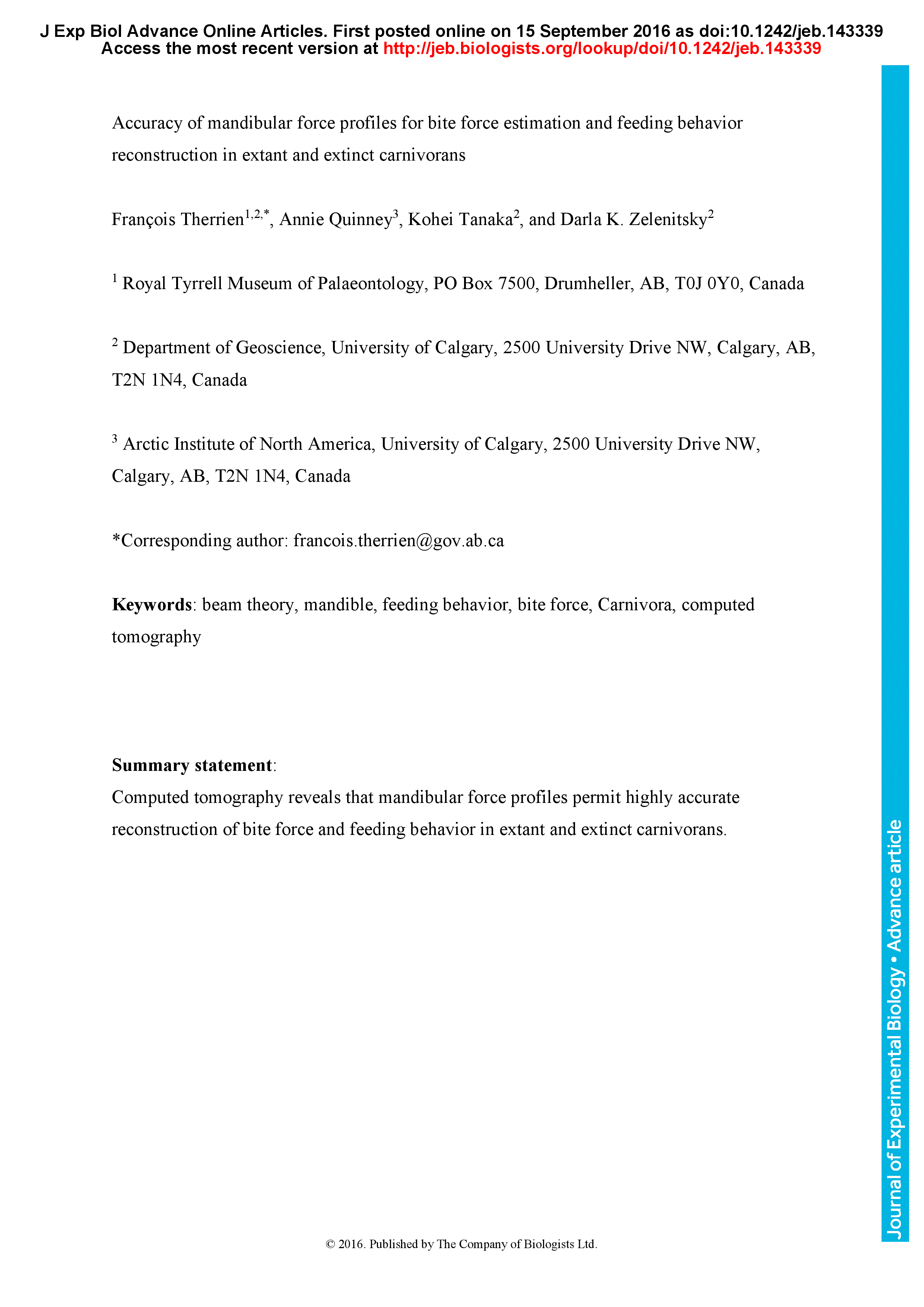Mandibular force profiles apply the principles of beam theory to identify mandibular biomechanical properties that reflect the bite force and feeding strategies of extant and extinct predators. While this method uses external dimensions of the mandibular corpus to determine its biomechanical properties, more accurate results could potentially be obtained by quantifying its internal cortical bone distribution. To test this possibility, mandibular force profiles were calculated using both external mandibular dimensions (‘solid mandible model’) and quantification of internal bone distribution of the mandibular corpus obtained from CT scans (‘hollow mandible model’) for five carnivorans (Canis lupus, Crocuta crocuta, Panthera leo, Neofelis nebulosa, and the extinct Canis dirus). Comparison reveals that the solid model slightly overestimates mandibular biomechanical properties, but the pattern of change in biomechanical properties along the mandible remains the same. As such, feeding behavior reconstructions are consistent between the two models and are not improved by computed tomography. Bite force estimates produced by the two models are similar, except for Crocuta where the solid model underestimates bite force by 10%-14%. This discrepancy is due to the more solid nature of the Crocuta mandible relative to other carnivorans. Therefore, computed tomography improves bite force estimation accuracy for taxa with thicker mandibular corpora, but not significantly so otherwise. Bite force estimates derived from mandibular force profiles are far closer to empirically-measured bite force than those inferred from jaw musculature dimension. Consequently, bite force estimates derived from this method can be used to calibrate finite-element analysis models.
Accuracy of mandibular force profiles for bite force estimation and feeding behavior reconstruction in extant and extinct carnivorans
Currently Viewing Accepted Manuscript - Newer Version Available
- Split-screen
- Views Icon Views
- Open the PDF for in another window
-
Article Versions Icon
Versions
- Version of Record 01 December 2016
- Accepted Manuscript 01 January 2016
- Share Icon Share
-
Tools Icon
Tools
- Search Site
François Therrien, Annie Quinney, Kohei Tanaka, Darla K. Zelenitsky; Accuracy of mandibular force profiles for bite force estimation and feeding behavior reconstruction in extant and extinct carnivorans. J Exp Biol 2016; jeb.143339. doi: https://doi.org/10.1242/jeb.143339
Download citation file:
Advertisement
2023 JEB Outstanding Paper Prize shortlist and winner

The JEB Editors are delighted to announce the shortlisted authors for the 2023 JEB Outstanding Paper Prize. Read the winning paper - Tiny spies: mosquito antennae are sensitive sensors for eavesdropping on frog calls - by Hoover Pantoja-Sanchez and Brian Leavell from Ximena Bernal's lab at Purdue University, USA.
JEB Science Communication Workshop for ECRs

If you’re an early-career researcher interested in science communication and are attending the SEB Annual Conference in Prague this summer, come a day early and join the JEB Editors at a sci comm workshop to learn the key writing skills needed to promote your research to a broad audience beyond your peers (1 July at 14.30-17.30). Places are limited to 24 attendees, and applicants should apply through the SEB registration page by 30 April 2024.
Bridging the gap between controlled conditions and natural habitats in understanding behaviour

Novel technologies enable behavioural experiments with non-model species, in naturalistic habitats and with underexplored behaviours. In their Commentary, Scholz and colleagues discuss how to obtain a deeper understanding of the natural ecology and lifestyle of study animals.
Beluga metabolic measures could help save species

To help save animals from extinction, it’s important to understand what each species needs to survive. This led Jason John et al. to measure the metabolic rates of captive belugas to develop a ‘fish calculator’ showing that the whales need to eat ~23 salmon per day.
ECR Workshop on Positive Peer Review

Are you an ECR looking for tips on how to write concise, astute and useful manuscript reviews? If so, join the JEB Editors at a 2-hour JEB-sponsored Workshop on Positive Peer Review at the Canadian Society of Zoologists annual meeting in Moncton on 9 May 2024 at 13.00-15.00. There are 25 spaces for ECRs and selection is first come, first serve. To sign up, check the ECR Workshop box when you register for the CSZ meeting.



